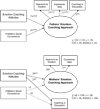Emotion Socialization by Mothers and Fathers: Coherence among Behaviors and Associations with Parent Attitudes and Children's Social Competence
- PMID: 21532915
- PMCID: PMC3082208
- DOI: 10.1111/j.1467-9507.2010.00585.x
Emotion Socialization by Mothers and Fathers: Coherence among Behaviors and Associations with Parent Attitudes and Children's Social Competence
Abstract
This study examined interrelations among different types of parental emotion socialization behaviors in 88 mothers and 76 fathers (co-residing with participating mothers) of 8-year-old children. Parents completed questionnaires assessing emotion socialization behaviors, emotion-related attitudes, and their children's social functioning. An observed parent-child emotion discourse task and a child social-problem solving interview were also performed. Parent gender differences and concordance within couples in emotion socialization behaviors were identified for some but not all behaviors. Fathers' reactions to child emotion, family expressiveness, and fathers' emotion coaching during discussion cohered, and a model was supported in which the commonality among these behaviors was predicted by fathers' emotion-coaching attitudes, and was associated with children's social competence. A cohesive structure for the emotion socialization construct was less clear for mothers, although attitudes predicted all three types of emotion socialization behavior (reactions, expressiveness, and coaching). Implications for developmental theory and for parent-focused interventions are discussed.
Figures
References
-
- Baker JK, Crnic KA. The relation between mothers’ reports of family-of-origin expressiveness and their emotion-related parenting. Parenting: Science & Practice. 2005;5:333–346.
-
- Baker J, Crnic K. Thinking about feelings: Emotion focus in the parenting of children with early developmental risk. Journal of Intellectual Disability Research. 2009;53:450–462. - PubMed
-
- Bell RQ. Parent, child, and reciprocal influences. American Psychologist. 1979;34:821–826.
-
- Campos JJ, Mumme DL, Kermoian R, Campos RG. A functionalist perspective on the nature of emotion. Monographs of the Society for Research in Child Development. 1994;59:284–303. - PubMed
-
- Carson JL, Parke RD. Reciprocal negative affect in parent-child interactions and children’s peer competency. Child Development. 1996;67:2217–2226. - PubMed
Grants and funding
LinkOut - more resources
Full Text Sources

